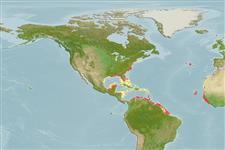Elasmobranchii (haaien en roggen) (sharks and rays) >
Myliobatiformes (Stingrays) >
Rhinopteridae (Cownose rays)
Etymology: Rhinoptera: Greek, rhinos = nose + Greek,pteron = fin, wing (Ref. 45335).
More on author: Mitchill.
Environment: milieu / climate zone / depth range / distribution range
Ecologie
marien; brak water benthopelagisch; oceanodroom (Ref. 51243); diepte 0 - 22 m (Ref. 26912). Tropical; 46°N - 42°S, 98°W - 33°W
Western Atlantic: from New England (USA) to northern Argentina (Ref. 114953); including northern Florida (USA), throughout the Gulf of Mexico, migrating to Trinidad, Venezuela, Brazil and Uruguay (Ref. 7251).
Lengte bij maturiteit / Grootte / Gewicht / Leeftijd
Maturity: Lm 65.3, range 62 - ? cm
Max length : 120 cm WD mannelijk / geslacht onbekend; (Ref. 5217); max. gepubliceerd gewicht: 953.00 g (Ref. 118626)
Deep grove around front of head below eyes; forehead above groove indented, snout below groove is distinctly bilobed (Ref. 26938). Disk brown to olive above, with no spots or marks, wings long and pointed (Ref. 7251). Lower surface white or yellowish white (Ref. 6902).
A benthopelagic species found on continental and insular shelves; enters bays and estuaries; forms huge schools inshore (Ref. 114953). Feeds mainly on benthic invertebrates and molluscs (implicated in damaging seagrass beds) (Ref. 93252, 114953). Jumps occasionally, landing with a loud smack, probably as a territorial display. Migrates south in large schools that disappear off northern Florida, USA and are not reported from Caribbean Is.; tagged fish have been recovered in northern South America (Ref. 7251). Population in the Gulf of Mexico migrates clockwise; schools of up to 10,000 rays leave west coast of Florida for Yucatan, Mexico in the fall (Ref. 7251). Ovoviviparous (Ref. 50449).
Levenscyclus en paargedrag
Maturiteit | Voortplanting | Paaien | Eieren | Fecunditeit | Larven
Exhibit ovoviparity (aplacental viviparity), with embryos feeding initially on yolk, then receiving additional nourishment from the mother by indirect absorption of uterine fluid enriched with mucus, fat or protein through specialised structures (Ref. 50449).
Last, P.R., W.T. White, M.R. de Carvalho, B. Séret, M.F.W. Stehmann and G.J.P. Naylor, 2016. Rays of the world. CSIRO Publishing, Comstock Publishing Associates. i-ix + 1-790. (Ref. 114953)
Status op de Rode Lijst van het IUCN (Ref. 130435: Version 2024-1)
Gevaar voor de mens
Traumatogenic (Ref. 4690)
Gebruik door de mens
Visserij: van minder commercieel belang; Aquarium: Publieke aquaria
Tools
Speciale rapporten
Download XML
Internetbronnen
Estimates based on models
Preferred temperature (Ref.
123201): 20 - 28.1, mean 26.7 °C (based on 643 cells).
Fylogenetische diversiteitsindex (Ref.
82804): PD
50 = 0.5039 [Uniqueness, from 0.5 = low to 2.0 = high].
Bayesian length-weight: a=0.01202 (0.00696 - 0.02076), b=2.98 (2.82 - 3.14), in cm total length, based on LWR estimates for this species & (Sub)family-body (Ref.
93245).
Trofisch niveau (Ref.
69278): 3.2 ±0.0 se; based on diet studies.
Weerstandsvermogen (Ref.
120179): laag, minimale populatieverdubbelingstijd 4,5-14 jaar (Fec assumed to be <100).
Fishing Vulnerability (Ref.
59153): High vulnerability (59 of 100).
